Publisher’s Note: This comparison originally appeared on the Polk Audio Forum. It appears hear courtesy of the author.
A few months ago I set out on a mission to do a comprehensive comparison of as many entry-level DACs as I could get my hands on. I use the term “entry-level” loosely, as I was looking at models under $500. Many people may not consider $500 an entry level price point for a DAC, and I’d agree that the dollar threshold is debatable. Nonetheless, there were DACs nearing the $500 mark I wanted to include and so I set that as the somewhat arbitrary price limit.
The goal was simple, yet a bit lofty. I would make a list of all the DACs I wanted to hear; acquire all those DACs simultaneously; burn them in; and then take a full weekend to do a ‘proper’ review-complete with full analysis and comparison of every model. This was going to be the be-all, end-all review and resource (all just my opinion, of course) for anyone looking at DACs in this price range.
Well, that didn’t work out like I planned. Stuff happens; life gets in the way; and I wasn’t able to get all the DACs simultaneously to do the review the way I’d envisioned. Instead, I ended up acquiring the DACs two or three at a time over the next couple months and doing the reviews somewhat piecemeal.
The end result is different than I’d imagined, but in retrospect this approach may have worked out for the best. I think the review and information as I’d originally planned to present it would have been overwhelming. The review I’m presenting here is already long enough… hard to imagine anyone sifting through dozens of pages of detailed listening notes on different models.
I’ve taken half a dozen or so external DACs and am providing some quick impressions on each model. I’ve also thrown in a couple built-in DACs like the Oppo and Squeezebox Touch as a helpful reference. You’ll note that every DAC meets the price criteria and also has a USB input—those were the two requirements.
This is not an in-depth review on any of the models, but rather a quick overview of each model. The revised goal then was to provide more of an overview; the objective is that you’ll come away with a better understanding of what each DAC sounds like.
The DACs
- Audio-GD NFB 3 – received a DOA unit; waiting on replacement
- Cambridge Audio DACMagic HRT Streamer II+
- Keces DA-151
- Musical Fidelity V-DAC Mk II
- Musiland Monitor 02
- Oppo 83-SE DACs
- Peachtree Audio DAC-iT
- Squeezebox Touch DACs w/upgraded linear power supply
- Schiit BiFrost
Methodology of review
 The listening was done primarily on a couple headphone rigs and then the results were ‘verified’ by doing some blind switching in the living room on the PSB Image B6 driven by a Pioneer SC. The HT setup, while good, is not as revealing as any of my headphone gear. My general approach was to formulate an opinion on the headphone rig, then have my wife assist with a blind test on the speakers, and luckily my opinions always lined up between the two, with an exception I’ll talk about later.
The listening was done primarily on a couple headphone rigs and then the results were ‘verified’ by doing some blind switching in the living room on the PSB Image B6 driven by a Pioneer SC. The HT setup, while good, is not as revealing as any of my headphone gear. My general approach was to formulate an opinion on the headphone rig, then have my wife assist with a blind test on the speakers, and luckily my opinions always lined up between the two, with an exception I’ll talk about later.
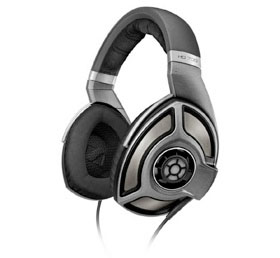 I have lots of headphone gear, but here’s what I used for the testing: Schiit Valhalla tube amp, Woo Audio WA6 tube amp, Sennheiser HD600, HD700 and Beyer Dynamic DT880 600-ohm version. The HD700 may be the best of the bunch but is new to me and I’m more familiar with the HD600 and actually prefer them, so I tended to use it as my reference headphone and brought in the others as necessary to confirm results or listen to something specific. All the headphone gear was connected to my iMac running Amarra HiFi on top of iTunes. Amarra replaces the crappy built in iTunes playback engine, providing superior sound and more importantly, automatic sample rate conversion. I have an engine I’ve been working on as well, but wanted to sitck with Amarra for this since it’s industry standard. DACs were connected via the Musical Fidelity V-LINK USB to SPDIF converter and directly via USB, each where possible and where needed, I’ll expound on this more as I review each DAC.
I have lots of headphone gear, but here’s what I used for the testing: Schiit Valhalla tube amp, Woo Audio WA6 tube amp, Sennheiser HD600, HD700 and Beyer Dynamic DT880 600-ohm version. The HD700 may be the best of the bunch but is new to me and I’m more familiar with the HD600 and actually prefer them, so I tended to use it as my reference headphone and brought in the others as necessary to confirm results or listen to something specific. All the headphone gear was connected to my iMac running Amarra HiFi on top of iTunes. Amarra replaces the crappy built in iTunes playback engine, providing superior sound and more importantly, automatic sample rate conversion. I have an engine I’ve been working on as well, but wanted to sitck with Amarra for this since it’s industry standard. DACs were connected via the Musical Fidelity V-LINK USB to SPDIF converter and directly via USB, each where possible and where needed, I’ll expound on this more as I review each DAC.
In the living room, I alternated between the Oppo and SB Touch as sources, although I used the Touch more often so I could play and compare the exact same files on both systems.
Listening Material
All tracks were lossless FLACs, confirmed accurate rip via dbPowerAmp or Hi Rez where indicated. You’ll notice that not all these are reference recordings, the ability to handle both excellently- and poorly-recorded music is important to me. I’ve marked those that I consider reference quality material with an *…hi rez tracks/HDTracks are marked with a +. The layout is “Artist – Album – Track Title.”
- Al Di Meola – Friday Night in San Francisco – Mediterranean Sundance *
- Alison Krauss – New Favorite – Let Me touch You For A While
- Chris Isaak – Heart Shaped World – Blue Spanish Sky Dave Brubeck – Time Out – Blue Rondo *
- Diana Krall – Live In Paris – Under My skin *
- Dire Straits – Brothers in Arms – Your Latest Trick * Dire Straits – Love Over Gold – Telegraph Road *
- Dream Theater – Awake – 6:00
- Dream Theater – Dramatic Turn of Events – Bridges In The Sky+
- Eagles – Hell Freezes Over – Hotel California
- Fleetwood Mac – Rumors – The Chain+
- Hans Zimmer – POTC At Worlds End – I Don’t Think Now is the Best Time *
- Head Fi – Open Your Ears – Money +*
- John Coltrane – Blue Train – Moments Notice
- John Powell – Bourne Ultimatum – Tangiers
- Mark Knopfler – Sailing to Philadelphia – Sailing to Philadelphia
- Massive Attack – Heligoland – Splivng The Atom *
- Muse – The Resistance – Symphony Part 1
- One O-Clock Lab Band – Lab 92 – Fingers
- Opeth – Blackwater Park – The Drapery Falls
- Pink Floyd – Wish You Were Here – Welcome to The Machine+*
- Porcupine Tree – Fear of a Blank Planet – Anesthetize *
- Rush – Moving Pictures – Tom Sawyer+
- Seal – Seal – Dreaming In Metaphors Spies – By Way of the World – Bahia *
- Steely Dan – Gaucho – Hey Nineteen+ *
- Sting – Ten Summoner’s Tales – Seven Days
- Tchaikovsky – Tchaikovsky Festival Leaper – Marche Slave *
- Vince Gauraldi – Charlie Brown Christmas – My Little Drum+
- Yo Yo Ma – Vivaldi’s Cello – Concerto in G Minor Allegro *
Review Results
These are my impressions, and the descriptions may be a bit informal for some people’s tastes, but these are just the notes I took and words that came to mind when I put pen to paper. So, in no particular order…
Cambridge Dacmagic, original version
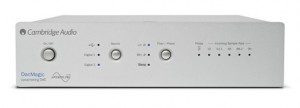 The Cambridge is fairly resolving but has no real sound to it; I guess sterile is the best word I can think of. One man’s sterile though could be another man’s extremely accurate. I’m sure the DAC is very accurate but honestly to me sounds a little lifeless. I’ve heard people say this DAC is typical Cambridge sound, but I’d only somewhat agree. I realize that Cambridge gear isn’t the most lively stuff out there but I’ve always found it pleasing to my ears, especially their small integrated and the 840 CDP that I heard. This one just seems to have less energy to the sound. There’s less impact than with the other models. With the DAC I preferred the sound using the V-Link converter as opposed to the USB on the DAC, but honestly it was very close, either way it didn’t materially impact the sound.
The Cambridge is fairly resolving but has no real sound to it; I guess sterile is the best word I can think of. One man’s sterile though could be another man’s extremely accurate. I’m sure the DAC is very accurate but honestly to me sounds a little lifeless. I’ve heard people say this DAC is typical Cambridge sound, but I’d only somewhat agree. I realize that Cambridge gear isn’t the most lively stuff out there but I’ve always found it pleasing to my ears, especially their small integrated and the 840 CDP that I heard. This one just seems to have less energy to the sound. There’s less impact than with the other models. With the DAC I preferred the sound using the V-Link converter as opposed to the USB on the DAC, but honestly it was very close, either way it didn’t materially impact the sound.
HRT Music Streamer 2+
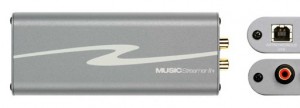 I did not care for the HRT at all. It has asynchronous USB and seems to be well liked but I just don’t hear it. It’s very digital sounding (yes I know that’s not all that helpful but it’s the best I’ve got). It’s not like there are artifacts in the music or anything dramatic, and it’s not really overly bright, but does lean in that direction. The instruments just didn’t sound real, the soundstage was flat. This DAC sounds exactly the same as the other HRT Streamer that I heard a while back, and I didn’t like that one either.
I did not care for the HRT at all. It has asynchronous USB and seems to be well liked but I just don’t hear it. It’s very digital sounding (yes I know that’s not all that helpful but it’s the best I’ve got). It’s not like there are artifacts in the music or anything dramatic, and it’s not really overly bright, but does lean in that direction. The instruments just didn’t sound real, the soundstage was flat. This DAC sounds exactly the same as the other HRT Streamer that I heard a while back, and I didn’t like that one either.
Musiland Monitor 02
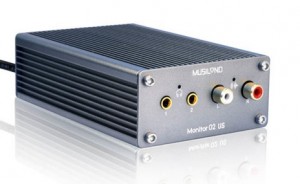 The Musiland is actually a good DAC at its price but just isn’t quite in the same league as the others. For me there was honestly no obvious sound characteristic or flaw with it like there were with the other two. It’s just not quite as detailed and the sound staging just isn’t quite as good as the other models. Simply put, there are things in the recording that I’m hearing with the other DACs that I don’t hear with this one. I’m not talking about obvious things like notes but more ambient sounds. When you hit a low C on a piano you not only hear that note but some slight harmonics as the adjacent strings vibrate a little as well… I don’t hear those as much thru this DAC. I have a recording of the One O’clock Lab Band at UNT from 1992, and on Track 2 there’s a part where I can hear the keys hivng the pads as the sax section plays through a part, but I can’t hear that very well on the Musiland. If Monitor 02 was the only DAC I’d ever heard, I’d likely be satisfied… and at its price it may be one of the best options, but knowing what I’m missing kills it for me.
The Musiland is actually a good DAC at its price but just isn’t quite in the same league as the others. For me there was honestly no obvious sound characteristic or flaw with it like there were with the other two. It’s just not quite as detailed and the sound staging just isn’t quite as good as the other models. Simply put, there are things in the recording that I’m hearing with the other DACs that I don’t hear with this one. I’m not talking about obvious things like notes but more ambient sounds. When you hit a low C on a piano you not only hear that note but some slight harmonics as the adjacent strings vibrate a little as well… I don’t hear those as much thru this DAC. I have a recording of the One O’clock Lab Band at UNT from 1992, and on Track 2 there’s a part where I can hear the keys hivng the pads as the sax section plays through a part, but I can’t hear that very well on the Musiland. If Monitor 02 was the only DAC I’d ever heard, I’d likely be satisfied… and at its price it may be one of the best options, but knowing what I’m missing kills it for me.
Musical Fidelity V-DAC Mk II
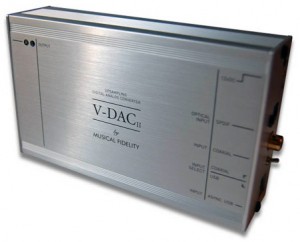 I had on hand both the original version of the V-DAC and the MKII. The main advantage of V-DAC Mk II is that it basically has the VLINK built it, so does synch USB itself. I hooked this one up directly via USB and through the VLINK and it sounds exactly the same. I also compared this to the original version and could not hear much difference. I told myself that this one sounded a tad better because it should sound better, but this is the one exception that I mentioned above where my blind test results in the HT did not line up with what I did on the headphone rig. It could be that my HT system isn’t revealing enough, or it could be that this really does sound just like the first version, either way on my setup it didn’t make a difference. I would describe the sound on this as similar to the Cambridge, but to a lesser degree. I found the Cambridge to be sterile, and while the V-DAC had more life to it, there was still something clinical about how it sounded. I don’t want to slight this DAC because it is very good and is actually what I used and recommended for a good while, but when compared to some of the other models here it just seems to be lacking in some regard, and the best way to describe that is a bit lifeless. I bet it’s a very bit-accurate DAC, but what I’m looking for is more impact to the sound, and I feel like it’s missing here, but only when compared to the other models.
I had on hand both the original version of the V-DAC and the MKII. The main advantage of V-DAC Mk II is that it basically has the VLINK built it, so does synch USB itself. I hooked this one up directly via USB and through the VLINK and it sounds exactly the same. I also compared this to the original version and could not hear much difference. I told myself that this one sounded a tad better because it should sound better, but this is the one exception that I mentioned above where my blind test results in the HT did not line up with what I did on the headphone rig. It could be that my HT system isn’t revealing enough, or it could be that this really does sound just like the first version, either way on my setup it didn’t make a difference. I would describe the sound on this as similar to the Cambridge, but to a lesser degree. I found the Cambridge to be sterile, and while the V-DAC had more life to it, there was still something clinical about how it sounded. I don’t want to slight this DAC because it is very good and is actually what I used and recommended for a good while, but when compared to some of the other models here it just seems to be lacking in some regard, and the best way to describe that is a bit lifeless. I bet it’s a very bit-accurate DAC, but what I’m looking for is more impact to the sound, and I feel like it’s missing here, but only when compared to the other models.
Schiit BiFrost
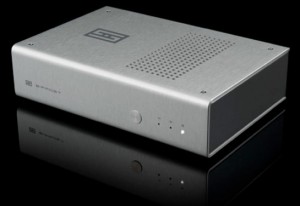 Ohhh, I wanted to like this one! I have a couple of their amps and they’re very good, and they’ve got an exciting new DAC coming out soon, and despite what other people say, I love the name. I tried this Schiit both ways, hooked via the MF VLINK and directly via USB. The USB implementation on this DAC is an afterthought, the guys who sell it are open about the fact that they’re not crazy about USB, the VLINK hookup option sounded better here by a good bit. That being said, I didn’t like the BiFrost all that much. It definitely had the impact I’m looking for, but carries with it more of a bright sound, I’d almost call it digital, kinda like the HRT Streamer but not to that extreme. The BiFrost brought too much of an edge to the sound. This doesn’t surprise me as even their tube headphone amps (which I own and love) have a bit of SS sound to them. It seems like the house sound for Schiit is a tad on the bright side of neutral. That works great with their headphone amps because it gives them a very balanced sound (a lot of tube amps almost sound too syrupy, especially the OTL amps I’ve owned), but not so much with this DAC. It is very revealing and very detailed, so if you’re looking for something to bring a warm sounding system back to neutral this just may do the trick; it just didn’t blend well with my systems which are all fairly neutral.
Ohhh, I wanted to like this one! I have a couple of their amps and they’re very good, and they’ve got an exciting new DAC coming out soon, and despite what other people say, I love the name. I tried this Schiit both ways, hooked via the MF VLINK and directly via USB. The USB implementation on this DAC is an afterthought, the guys who sell it are open about the fact that they’re not crazy about USB, the VLINK hookup option sounded better here by a good bit. That being said, I didn’t like the BiFrost all that much. It definitely had the impact I’m looking for, but carries with it more of a bright sound, I’d almost call it digital, kinda like the HRT Streamer but not to that extreme. The BiFrost brought too much of an edge to the sound. This doesn’t surprise me as even their tube headphone amps (which I own and love) have a bit of SS sound to them. It seems like the house sound for Schiit is a tad on the bright side of neutral. That works great with their headphone amps because it gives them a very balanced sound (a lot of tube amps almost sound too syrupy, especially the OTL amps I’ve owned), but not so much with this DAC. It is very revealing and very detailed, so if you’re looking for something to bring a warm sounding system back to neutral this just may do the trick; it just didn’t blend well with my systems which are all fairly neutral.
Oppo 83 SE DACs
I have the Oppo 83 Special Edition, which I believe has either Sabre or Wolfson DACs, think it’s Sabre. [8-‐channel Sabre32 Ultra (ES9016) DAC for audio… Ed.] I decided I’d throw this in the mix to get some perspective of the value of an external DAC over a very good transport DAC. I honestly didn’t get the results I expected. I was looking for a night and day kind of difference and didn’t get that at all. Whatever they did in this player was well done. It has a very smooth and detailed sound, I ended up falling in love with my Oppo all over again doing this test. It doesn’t quite have the impact that my favorite DAC has, but it’s very, very close. This makes me happy, because this is what I use for SACD playback, it was nice to see it stack up so well against the other models. It wasn’t really fair to throw this one in the mix since it can’t be used as a stand-‐alone DAC and therefore can’t serve that purpose, but I wanted to give some additional perspective nonetheless.
Squeezebox Touch DACs
The Touch actually has a nice built in AKM DAC. I’m not familiar with that company but they appear to make several DACs and I read somewhere that the DACs in my Pio SC are also AKM. The best way I can describe their sound is a very balanced overall sound. They don’t really do anything wrong, and yet don’t do anything outstanding either.
Honestly though, most people would be perfectly satisfied with this DAC. If I’d never heard anything else I would be satisfied using this DAC. It has better sound than the DACs in my AVR and I used the built in DAC for some time after I got the Touch, and posted lots about how much I liked the sound. The issue arises when you compare it t a very good external DAC, it just doesn’t have the resolution, high-‐end extension and low-‐end impact that my favorite external DACs have. In comparison, even the Oppo’s DAC sounds better than this one, but not by a mile. A small plug for the Touch, it’s a great device and WILL change the way you listen to music, especially when paired with a good DAC and a decent power supply.
Keces DA-151 Mk II
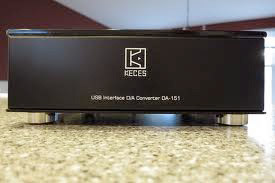 The Keces DA-151 MkII surprised me a little… actually a lot. Of all the models I tested, this was on the cheaper side. It is a USB only DAC, so using the VLINK was out of the question as was testing in the HT system, only USB to computer on the headphone rig. What a superb sounding DAC! The very first things I noticed was the soundstage, a very wide open soundstage. This thing paired with the Beyers was unreal, almost literally. This thing just has a very transparent, neutral sound overall. It’s hard to describe, it just sounded perfect. If I had to criticize I’d say it can be a little forward sounding, but that’s getting picky and not even consistent from track to track, but on some vocal-focused tracks it does tend to happen. The DA-151 Mk II is the perfect case of a DAC not being all about the chip used but more about the design. I believe the chip used in this model is a fairly standard TI chip that I’ve seen used in a lot of other models, so it’s not like they’ve got some super-duper chip in there, they’ve just done a brilliant job designing it. So is this my favorite DAC? It’s hard to imagine something sounding much better than this so it has to be, right? No. There are two reasons this is not my favorite DAC. Mainly, it’s USB only and simply won’t work for everyone, hell it won’t even work for me in my HT. For a USB setup at its price, there simply cannot be a better DAC on the planet, but if you need a multi-purpose DAC this isn’t the one for you. Secondly, I tested a DAC that sounds even better!
The Keces DA-151 MkII surprised me a little… actually a lot. Of all the models I tested, this was on the cheaper side. It is a USB only DAC, so using the VLINK was out of the question as was testing in the HT system, only USB to computer on the headphone rig. What a superb sounding DAC! The very first things I noticed was the soundstage, a very wide open soundstage. This thing paired with the Beyers was unreal, almost literally. This thing just has a very transparent, neutral sound overall. It’s hard to describe, it just sounded perfect. If I had to criticize I’d say it can be a little forward sounding, but that’s getting picky and not even consistent from track to track, but on some vocal-focused tracks it does tend to happen. The DA-151 Mk II is the perfect case of a DAC not being all about the chip used but more about the design. I believe the chip used in this model is a fairly standard TI chip that I’ve seen used in a lot of other models, so it’s not like they’ve got some super-duper chip in there, they’ve just done a brilliant job designing it. So is this my favorite DAC? It’s hard to imagine something sounding much better than this so it has to be, right? No. There are two reasons this is not my favorite DAC. Mainly, it’s USB only and simply won’t work for everyone, hell it won’t even work for me in my HT. For a USB setup at its price, there simply cannot be a better DAC on the planet, but if you need a multi-purpose DAC this isn’t the one for you. Secondly, I tested a DAC that sounds even better!
Peachtree DAC-iT
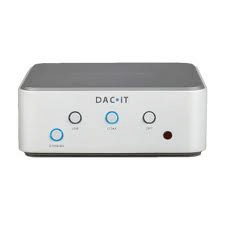 The Peachtree DAC-iT is, simply put, the best DAC I’ve ever had in my possession. Is it as good as one of the more expensive models like the Benchmark or W4S DACs? I don’t know, this is an entry level comparison. In reality, it’s hard to even call this an entry level DAC. But at $450, it is on the low end in terms of price in the overall world of DACs, though on the higher end of all the DACs here. The sound of this thing is just perfect, it’s hard to imagine anything better yet I know there are lots of more expensive DACs out there. The sound is very musical, the DAC-iT is just fun to listen to. I would call this very neutral, but if I had to narrow it further I’d say it’s just a tad warm of neutral, it has a very ‘analog’ sound to it. I know that’s another audio buzzword, but that’s the best way I can think of to describe it. The top end is a tad soft but still very detailed, the mid range is also very detailed but just a tad recessed, and the low end is just extraordinary. The soundstage isn’t quite as wide as the Keeces’, but still very realistic and the imaging overall is better on the Peachtree. I compared this unit using both the built in USB and using the V-LINK adapter. It sounds very similar both ways, as time passes and I become more familiar with this DAC I may decide that I like one approach better, for now I’m using the V-LINK so that turning off the DAC doesn’t confuse iTunes or Amarra about which device is connected. I am on the hunt for a linear power supply for this DAC, I’d like to hear how that affects the sound.
The Peachtree DAC-iT is, simply put, the best DAC I’ve ever had in my possession. Is it as good as one of the more expensive models like the Benchmark or W4S DACs? I don’t know, this is an entry level comparison. In reality, it’s hard to even call this an entry level DAC. But at $450, it is on the low end in terms of price in the overall world of DACs, though on the higher end of all the DACs here. The sound of this thing is just perfect, it’s hard to imagine anything better yet I know there are lots of more expensive DACs out there. The sound is very musical, the DAC-iT is just fun to listen to. I would call this very neutral, but if I had to narrow it further I’d say it’s just a tad warm of neutral, it has a very ‘analog’ sound to it. I know that’s another audio buzzword, but that’s the best way I can think of to describe it. The top end is a tad soft but still very detailed, the mid range is also very detailed but just a tad recessed, and the low end is just extraordinary. The soundstage isn’t quite as wide as the Keeces’, but still very realistic and the imaging overall is better on the Peachtree. I compared this unit using both the built in USB and using the V-LINK adapter. It sounds very similar both ways, as time passes and I become more familiar with this DAC I may decide that I like one approach better, for now I’m using the V-LINK so that turning off the DAC doesn’t confuse iTunes or Amarra about which device is connected. I am on the hunt for a linear power supply for this DAC, I’d like to hear how that affects the sound.
More notes comparing the Keces and Peachtree:
This is personal preference, but poor recordings sound better on the Peachtree, especially on my headphone rig. The Keces is probably more transparent and probably specs out a tad better on paper and may be more ‘correct’, and that’s what you want from a DAC. However, with any audio gear there’s always the trick of getting the balance between listenability and accuracy correct. I have ~4500 CDs and a wide range of musical tastes, with that size collection there are bound to be poor recordings, some of my favorite music falls into that category. The Peachtree just nails that combination, I don’t feel like I’m losing any details in the music and yet it smoothes over some of the edges in poor recordings. I don’t feel like it’s coloring the sound either, which is what you’d normally find, it’s very transparent and yet still manages well with poor records. That’s somewhat of an oxymoron I know, but that’s what it is.
Review Conclusions
One thing that none of these DACs handled especially well was really ‘dense’ music, there were a few classical pieces that were just too involved that none of these DACs could really untangle very well. However, I’ve omitted that from each review as it’s very plausible that none of the gear in my possession is high end enough to properly handle those passages.
The comparison was a lot of fun, I suppose I’ll end by ranking the best I can in order of preference
Top-6 Entry-Level Dacs
- Peachtree Audio DAC-iT
- Keces DA-151
- Oppo 83-SE DACs
- Musical Fidelity V-DAC
- Schiit Bifrost
- Squeezebox Touch DAC
All others sorta end up in a tie for… “don’t like very much.”
By Dánny Scárbrough affordableaudio.org
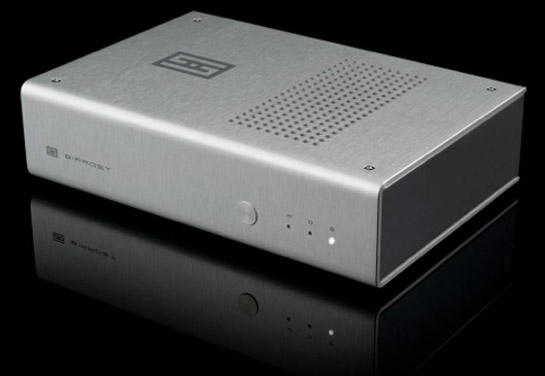

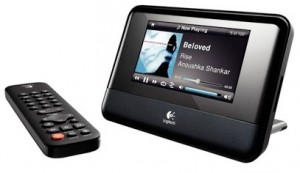
I know this is old, but I would love to buy a Keces DAC, but cannot find one. I’m guessing they went out of business?
For those who are searching for a better power supply for the Peachtree DAC ITx: I purchased the iFi iPower for some 50 euro and it is stunning good for the money.